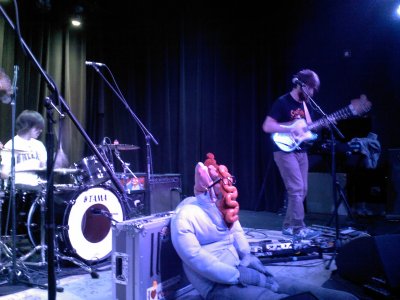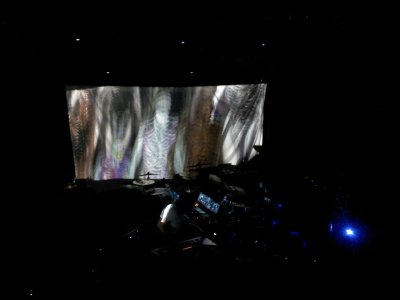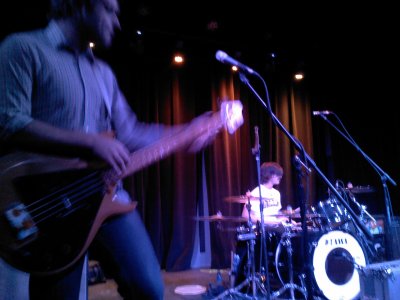Year end top-ten lists are something I’ve done for every music-related publication I’ve ever contributed to and I’m sure not going to stop now. But first, some ground rules. This list merely reflects my opinion on my favorite albums of this year and doesn’t necessarily relate to the bass guitar performances on these records. So this isn’t really a “best bass-nerd albums of 2013” list, its simply the albums I liked the most. This is also confined to the limited listening that one does when they can’t afford to buy many records in a year, so there’s alot of good stuff that I’m sure I missed out on.
Here are some mentions that didn’t quite make the top ten that I still felt deserved some recognition. I’m ashamed at the lack of hip-hop, I still haven’t had time to listen to Deltron 3030’s Event 2 and I’m just now warming up to the awesomeness that is Death Grips’ The Money Store.
Native – Orthodox: These spunky math-punk kids grow up alot and find their footing on this solid, smart, and accessible post-hardcore statement.
Chelsea Wolfe – Pain is Beauty: I may not be thoroughly familiar with this gifted sing/songwriter yet, but it’s obvious through her more developed, brooding alt/pop work on this record that big things are in store for her.
Russian Circles – Memorial: Darker, heavier, yet somehow still as dynamic, cinematic, and contrasted as always. I don’t think it’s possible for this trio to put out a bad album. And as always, bassist Brian Cook (formerly of the un-touchable Botch) brings forth some of the most monstrous tones imaginable. Even when not playing “riffs” per se, Russian Circles can sure capture a mood.
Jaga Jazzist – Live with the Britten Sinfonia: I don’t normally put live albums on top ten lists although this one is good enough to have almost made it. Beautiful, non-denominational instrumental pieces brought together with the added symphonic backing of the Britten Sinfonia, along with Jaga’s already awe-inspiring array of sounds.
Tera Melos – X’ed Out: It’s not often in this day and age that a band can come along and truly fill you with a hope that punk rock may finally be moving along somewhere. On this record Tera Melos further carve out their freaky math-pop niche to be enjoyed equally by stompbox nerds and spazzy skater kids everywhere.
Grails – Black Tar Prophecies 5-8: This is one I’m ashamed to say I simply haven’t had a chance to really listen to yet, especially considering Deep Politics was one of my favorite albums of 2011 and Grails have yet to do anything sub-par. I’m sure I’ll love it.
And now, my year end picks for 2013.
10. East of the Wall – Redaction Artifacts
There are few bands that embody what I personally believe prog-metal should be. For what it’s worth, East of the Wall is one of them. For those of you who believe that prog metal can be more than djent kids who just discovered the polyrhythmic chug of Meshuggah three years ago and Dream Theater obsessed guitar nerds, you’ll be pleased to hear that these New-Jersey natives actually write good songs. Redaction Artifacts could be East of the Wall’s most accessible album yet in the sense that there are plenty of moments that bypass the heady musician tendecies that bands like this tend to have and go straight for the head-banging reflexes. That’s not to say that this is the year’s metal album of all metal albums that will please all pit-dwellers, but there’s still enough going on here that fans of prog, post-rock, sludge metal, and more will find something to latch onto. Although I still argue that their melodic moments shine the most. The vocals don’t tread on the normal cringe-worthy clean vocal metal stylings, and the crystal clear delay driven guitar fusion on “The Fractal Canopy” helps unfold the track into a beautiful panoramic view. There’s still plenty of chops there if you’re into that sort of thing, and former guitarist Chris Alfano gives an awesome bass performance on this record.
9. Flaming Lips – The Terror
I have a hard time understanding why critics were so hard on this one, maybe it wasn’t Yoshimi Battles the Pink Robots or Soft Bulletin but it’s my belief that a band shouldn’t always be compared to their touchstone album whenever they decide to release something. This is actually the direction that I hoped to see The Flaming Lips go in after the aggro-psych trips of Embryonic, which strangely was more well received than this recent long-player. I’m not saying that I think The Terror is perfect, there are certain tracks that establish a mood well but aren’t going to jump out of your speakers and grab you by the ears. But the Lips’ new more melodic and cinematic song-craft works well with their newfound dedication to weirdness wherever possible and it makes for a well balanced result. “Try to Explain” builds up enough to almost bring them trying their hand at psychedelic post-rock to mind, and for me that’s A-OK.
8. Bosnian Rainbows – Bosnian Rainbows
I knew good and well that I probaby wasn’t going to love Omar Rodgriguez-Lopez’ new project as much as I did the first two Mars Volta albums, so I kept my mind open and proceeded with cautious optimism when it came to listen to Bosnian Rainbows’ debut album. But it really doesn’t matter how this band compares because Omar has never been about repeating himself. Bosnian Rainbows is the first fully collaborative project he’s done since At the Drive-In, so until now he had been in the driver seat since 2002. You can hear each individual musician’s voice on this self-titled debut and theirin lies the album’s value. I wasn’t huge on the modern sounding synth pads at first but the album’s digital manipulation is endearing after a while, and like I said each individual “part” complements each other well enough to form a stronger “whole”. Danceable, yet still dark and provoking, this is a great record that’s likely to dissapoint only the six-stringers shaking their head in disbelief at the lack of wah-heavy solos.
7. Steven Wilson – The Raven that Refused to Sing
I’ll occasionally mention my distaste for modern prog, mostly for it’s over-polished production, lack of creativity, and general lack of non-Dream Theater identity. Porcupine Tree have been a bit of an exception, yet I always suspected that they were capable of being more adventurous than they’ve led on in their 20+ year existence. What I wouldn’t have expected was that a solo album by their frontman Steven Wilson would end up being the album I always hoped Porcupine Tree would make. Normally solo albums are excuses for stripped down, “I’m ready for my close-up” self-indulgence, but in this case Wilson brings forth a colorful cast of talented musicans to bring his even more ambitious ideas to life. It was actually my love affair with his collaboration with Opeth’s Mikael Akerfeldt (last year’s Storm Corrosion LP) that convinced me there was more to this Brit than I realized. The main reason this album is on this list is that the songwriting, while great, still needed to be presented in a varied sonic palette to be truly memorable, and thankfully it has that. You’ll hear flutes darting in an out, an array of organ/key/synth sounds, and Wilson’s mad-scientist style sound experimentation on any number of other instruments. Don’t get me wrong, this is still pretty accessible rock, but it’s a step in the right direction and succeeds in marrying some genuine classic prog with the modern.
6. Mouth of the Architect – Dawning
Mouth of the Architect had a tumultuous few years after the release of what I thought was one of the best non-Isis post-metal albums ever, 2006’s The Ties That Blind. After near band collapses, line-up changes, and some honestly underwhelming releases it was difficult to say where they would head next if anywhere. Their first LP in five years, Dawning, reflects that, and a sense of hope that comes with moving forward. The tumult is there as well, but Dawning‘s imperfections, such as the album’s drum sound that has been highly criticized since it’s release, can be a bit endearing. At it’s best this is ambient-sludge in top form, balancing heart-wrenching emotional and bone-crushing brutality. The album deserves recognition for “It Swarms” if nothing else. While the first half of the track seems business as usual, the second half contains one of the most powerful ascents I’ve heard in this style of music in many years. Post-metal may not be “cool” anymore, but Mouth of the Architect have proven that it still needs to be made, and that it can be made competently.
5. Palms – Palms
Ok so maybe this collaboration ended up sounding alot like what we should have expected from Chino Moreno of Deftones fame teaming up with 3/5 of Isis, but no one ever said that was a bad thing. As a matter of fact the Palms debut is the probably what latter era Isis fans have been having wet dreams about since 2010. As you could guess, the hypnotic, insterstellar atmosphere laid down By Aaron Harris, Jeff Caxide, and Bryant Clifford Meyer are pretty much a perfect pairing with Chino’s signature, lightly-drifting vocals. He also knows from his Deftones days, when to put a little more oomph behind the heavier moments that you’re sure to get when you get former members of Isis together. The end result is a dynamic album that unfolds beautifully in front of the listener, as these songs are much more than mere throwaway Wavering Radiant tracks. Of course I can’t go without mentioning the contribution of one of my favorite bass players, Jeff Caxide. Jeff’s ethereal minor key grooves occupy many different sonic spaces as always, and his tone is instantly recognizable with his brilliant reverb/delay work.
4. Sigur Ros – Kveikur
There were a couple of things that made the new Sigur Ros LP Kveikur, finally hit home with me. The first was reading that the album was meant as a companion to last year’s Valtari, meant to show off the two opposing sides of the Icelandic group’s sound. That might not seem important, but it cleared up why they released another album so quickly, and why it’s so drastically different than Valtari. The second thing was hearing these songs in person, as a part of one of the greatest live music experiences I’ve ever had. And while I do believe that these songs will hold a greater place in your heart when experienced that way, that doesn’t mean you can’t love Kveikur for the great album that it is anyway. While it’s more aggressive, catchy, and rock than anything else they’ve done, Kveikur is still a Sigur Ros album. There may not be any hugely dramatic post-rock buildup like Takk… or the thoroughly atmospheric Valtari, but the trimmed-down presentation of this group’s emotional range has actually done them some good. Distorted, digital bass parts, shorter songs, and catchy vocal melodies are all things you’ll find to be pretty commonplace within this album. I’m not saying it’s their best, I’m just saying that it’s actually kind of refreshing to hear an album that almost sounds like it could have been a collaboration between Jonsi and Radiohead.
3. Deafheaven – Sunbather
And then there are times when you can believe the hype. With Sunbather, Deafheaven created something that I’m sure made a fair number of metal-heads cringe when read on paper, as their unique brand of metal owes as much to 90’s screamo as it does shoe-gaze and black metal. I’m sure the fact that they are from Portland probably doesn’t help their kvlt cred in certain circles either, but not only do I not care about that kind of thing, it’s impossible to deny that these guys made a hugely compelling and provocative album. Sunbather showed that there are still new things that can be done with black metal, and that a more full range of emotion doesn’t have to dampen a metal record. Normally melodic moments and cross-pollination can be tricky territory for a heavy band, but Sunbather touches on triumphant major key hopefulness, darkened despair, and plenty of ground in-between flawlessly. This album is good enough that a narrative feels present even if you can’t understand the lyrics, and the perfectly balanced production avoids garage-demo black metal quality just as well as it does over-produced modern polish. Believe the good things you’ve heard about this album, it’s an experience like none other.
2. Bibio – Silver Wilkinson
I had the good fortune of discovering Bibio in 2008 and since then, he (Stephen Wilkinson) has not put out anything less than stellar. The J-Dilla influence of 2009’s Ambivalence Avenue signaled a bit of a (brilliant) direction change for Bibio’s eclectic, self-described “folktronica”, but 2011’s Mind Bokeh leaned more towards dance music. While it was still great, I’m thankful that the ethereal Silver Wilkinson tones the danceability down a bit. This album continues to develop the folksy experiments of Bibio’s earlier work while still utilizing analogue electronics to create dreamy pop. There aren’t many songs one would describe as singles, it’s best experienced as a whole although there are still some standout moments. The Dilla-isms of DJ track “You” hearken back to Ambivalence Avenue while the old-school thump of a P-bass(?) in “A Tour a L’heure” help carry it as a perfect summer pop song. The production is hazy and probably meant to make you think of vintage recordings, with Stephen’s reverbed-out vocals drifting over each track. Nothing wrong with any of that I say, and Silver WIlkinson futhur instates the man can do no wrong.
1. Intronaut – Habitual Levitations (Instilling Words with Tones)
If you by chance read this site or know me personally this probably wasn’t a huge surprise. I’ve been pitching an ever growing tent for this band since 2008’s Prehistoricisms and it doesn’t look like it’s going down anytime soon. With each release since then, This LA group seems to incorporate more of what I love about music into what they do, so you might say I’m a bit biased since this album caters directly to me. Intronaut have transcended terms like “metal”, “progressive”, and post-whatever to find something truly their own. It’s something that revolves around groove, polyrhythm, aggression, ambience, tone, and an odd blend of western and eastern harmony that culminates in true ecstasy.
The lack of extreme vocals might get to some, but personally I think the sort of stoned, Aaron Turner reminiscent clean singing is a great contrast to the heaviness of some of these riffs. While this album is certainly Intronaut’s most melodic material yet, it isn’t without dissonance and experimentation. Take the vocal harmonies of “Steps” for instance, which seem to dodge a recognizable western mode just enough to establish a feeling that most bands would be afraid to attempt. Genres like jazz, sludge, and space-rock don’t rear their heads here as much as they meld together fluidly, Intronaut are not a multi-genre band desperately looking for admiration from other musicians. Joe Lester’s bass tone/performance is stupefying as always, with his ability to both rhythmically and melodically give riffs a greater context and carry the song. The ear candy of his fretless Zon five-string has plenty of punch too. Danny Walker’s drumming is brilliant as always, and whether coaxing out adventurous chords with gorgeous delay tones or laying down smoky, down-tuned crunch, the guitar work of Sacha Dunable and Dave Timnick shine brightly.
While I would certainly say that tags like prog, metal, post-rock, and sludge shouldn’t scare away those of you who don’t listen to those genres, I will also say that Habitual Levitations is not for everyone. As the name implies it’s an unearthly adventure, one that you’ll be continually rewarded again and again for taking.





